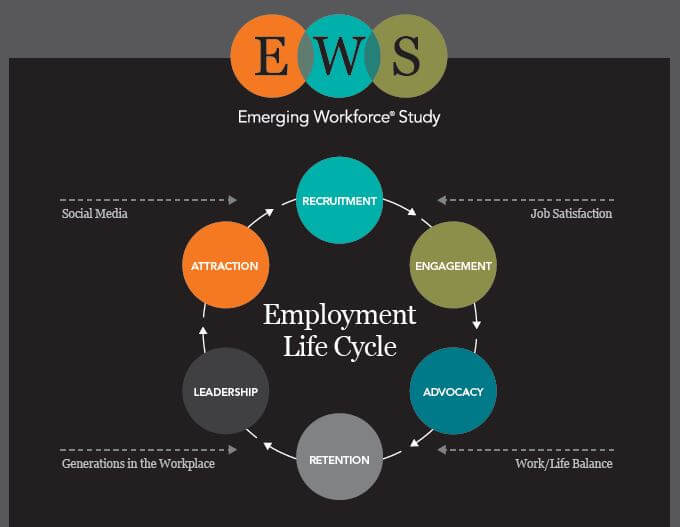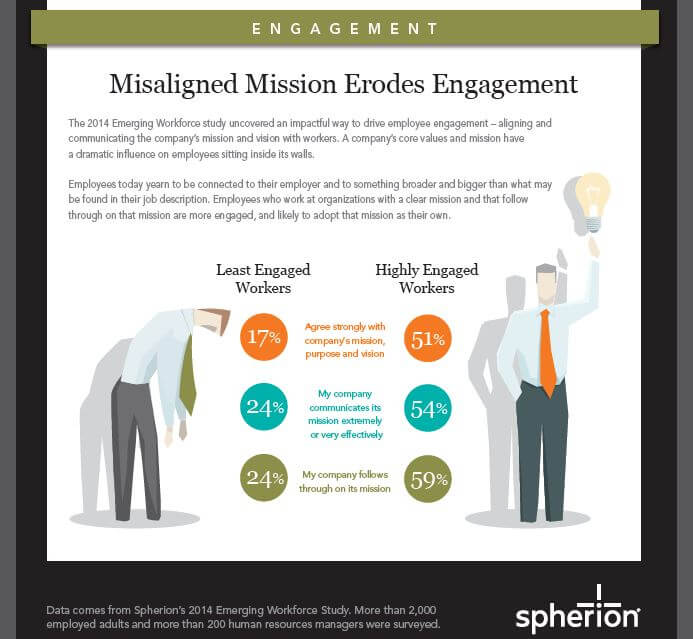I’m a sponsored blog partner with Spherion (a staffing and recruiting organization) and am participating in the release of findings from Spherion’s 2014 Emerging Workforce Study. All opinions are mine.
Employee engagement continues to surface as a hot topic in research on trends that impact the workplace. That’s what I homed in on when reviewing results from Spherion’s latest research project, the Emerging Workforce Study 2014. This study, which was conducted by Harris Interactive, has been ongoing for over 15 years. Over the years, Spherion has examined the issues and trends that affect the employment “life cycle.” The employment life cycle (noted below) includes attraction, recruitment, engagement, retention, advocacy and leadership.
More than 2,000 workers and 230 human resource managers were surveyed on their opinions and attitudes around critical workplace topics such as recruitment, employee engagement, job satisfaction, retention, employee advocacy, social media use, generational differences and work/life balance.
Not surprisingly, it’s in the “leadership” portion of the life cycle that my interest lies. Spherion’s research uncovered (and, in some cases, supports previous evidence for) trends that HR managers and business leaders would be smart to heed.
As you might expect, there’s a connection between employee engagement and a company’s mission. (See the “Engagement” section that’s excerpted from the full infographic.) Employees who self-identified as “highly engaged” in their work agreed that their company follows through on its mission. There was also a connection between how well the company communicates its mission and how “engaged” employees reported feeling.
On a gut level, this makes sense – employees who are aligned with a mission would also feel more “engaged” in their work. Conversely, employees who are mentally “checked out” or doubt the company’s mission reported lower levels of engagement.
Which raises an interesting question: does one state of being produce the other? Is an employee that is not that interested (or emotionally connected to) the company’s mission going to naturally feel less “engagement” than those who are strongly connected to the organizational goals and purpose? This has implications for the “recruitment” portion of the life cycle: you’d better hire people who are aligned to the goal, or it’s an uphill (or, depending on how you look at it, downhill) battle from the get-go.
These types of research studies provide a fascinating window into the inner workings of both an employer’s culture and employees’ thinking regarding their place of employment. While none of these statistics should be taken that THE final truth, they can certainly help HR managers and company leaders bridge any gaps between company goals employees’ perceptions of their workplace.
See the Spherion’s full infographic here: Spherion EWS Employment Life Cycle Infographic (first 3 phases)
Want more information on the Emerging Workforce study? You can see information from past EWS studies here. You can also follow Spherion on Twitter (hashtag #EWS2014) or join them on Facebook.
Disclosure: Spherion partnered with bloggers (like yours truly) for their Emerging Workforce Study program. As part of this program, I received compensation for my time. I was free to form my own opinions about the data supplied by Spherion and all opinions are my own. Spherion’s policies align with WOMMA Ethics Code, FTC guidelines and social media engagement recommendations.


Leave a Reply